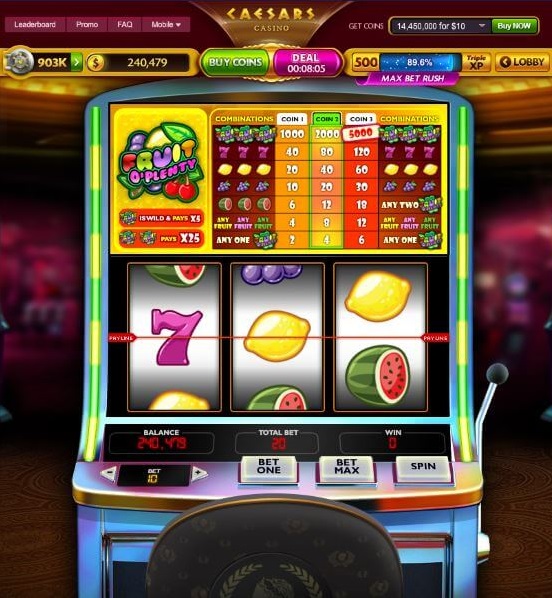Video slot machines. Video slot machines do not use mechanical reels, instead of using graphical reels on a computerized display. As there are no mechanical constraints on the design of video slot machines, games often use at least five reels, and may also use non-standard layouts. Because most players do not understand how slot machines work, whole sets of beliefs have grown over when to play a machine and when to avoid it. Little truth is in any of them. Here's a look at some of the more pervasive slot myths: Change machines after a big jackpot - the machine won't be due to hit again for some time.
Payout table
The pay table shows the player what combinations pay out and how much.
Winning lines
Most machines have multiple winning lines on the reels, so options are given for how many lines the player wants to bet. Each line is equal to one bet, so on a five-cent machine, betting on five lines would equate to betting 25 cents.
Coin bin
Though many machines print redeemable tickets, machines that pay out in coins have a large bin to catch them.
Credit meter

A credit meter keeps track of how much credit the player currently has as well as winnings when the reels are spun.
Credits are often used instead of showing actual cash amounts because, to the player, losing credits may not seem as negative as losing money.
Arm or button
Once the player has selected how many lines they want to bet, pulling the arm or pressing the bet button locks the settings, selects a random number, and spins the reels.
RNG
The RNG continuously generates thousands of numbers per second while the machine is on.
Some RNGs may use a device that collects thermal noise and converts it into electrical signals to help generate the numbers, as computers alone are only able to generate pseudo-random numbers.
EPROM

The EPROM (Erasable Programmable Read-only Memory) controls the weighting of the machine to make sure the desired payout percentage is reached.
(See “Odds & Weighting' section below).
Bet button
When the bet button is pressed, the number generated by the RNG at that exact moment is selected and used.
Reels
Reels are for show, and by the time they’re spinning the machine already knows what the outcome will be. Spinning and stopping reels in sequence helps build suspense and excitement for the player, keeping them more interested.
Stops
Each reel usually includes 20 to 30 stops, which are the symbols and blank spaces on the reel.
Odds & Weighting
Over many random play sessions, odds are predictable. By adjusting payouts for winning spins, casinos observe legal requirements while delivering an entertaining experience.
Payouts
How Do Mechanical Slot Machines Work Together
Odds are predictable over time,
so adjusting payouts per possible winning spins
yields predictable results over many random play sessions
Required legal payout percentage
Many states have laws that require certain payout percentages. For example, a machine that returns 85 or 90% of the cash it receives over time would still give the casino a 10% - 15% cut.
Weighting
The programmable EPROM allows weighting to fine-tune the play experience.
For example, if a reel has 10 blank spots, as long as that quota is met, it doesn't matter which blank spots are used. The machine could be programmed to land on blank spots around jackpots to give the player the impression of a 'near win.'
Stacking the odds:
multi-reel machines
How Do Mechanical Slot Machines Work Video
On a multi-reel machine, the odds of winning decrease exponentially. For example, taking the single reel example from above and multiplying it to 3 reels (all with identical symbols as the first), the chances of a winning combination (3 of the jackpot symbol instead of 1) drop from 1/20 chance to 1/8000 chance.

Anti-tamper
Slot machines are designed to be tamper proof to both the players and the casino.
Cabinet & screen
The cabinet and screen act as a faraday cage to disperse electricity and ground electrical signals, preventing outside electrical signals from interfering with the machine’s processes. The screen is coated in a clear, electrically conductive chemical, and connects to the metal cabinet to allow conductivity between the two.
Coin comparator
The coin comparator accepts or rejects coins that are put into the machine. It compares incoming coins against a coin previously placed in the comparator (e.g. if a nickel is in the comparator, then the machine would only accept nickels).
EPROM
The EPROM is programmed and tested in factory, then placed in the machine with a tamper evident sticker over it. This style of chip is reprogrammable using ultraviolet light and must be removed from the machine to do so, which is allowed only when a gaming authority is present.
Coin dispenser
Coin dispensers use a light sensor to count the number of coins dispensed.
Reels
Reels have sensors that detect extra movement, so trying to move reels manually causes an error to display on the LCD screen and any winnings are negated.
References
- (2017). Retrieved 7 January 2017, from https://www.reddit.com/r/IAmA/comments/clins/my_job_is_writing_software_for_slot_machines_and/
- Slots Random Number Generator - Hit Frequency vs Payout Ratio. (2017). Casino News Daily. Retrieved 7 January 2017, from http://www.casinonewsdaily.com/slots-guide/random-number-generator-hit-frequency-vs-payout-ratio/
- CC-40 A Coin Comparitor - YouTube. (2017). YouTube. Retrieved 7 January 2017, from https://youtu.be/k9ybYjS8jOI
- How Slot Machines Work. (2017). HowStuffWorks. Retrieved 7 January 2017, from http://entertainment.howstuffworks.com/slot-machine.htm
- Patent US4448419 - Electronic gaming device utilizing a random number generator for selecting the reel stop positions. (2017). Google Books. Retrieved 7 January 2017, from https://www.google.com/patents/US4448419
- How It’s Made Slot machines. (2017). YouTube. Retrieved 7 January 2017, from https://youtu.be/wjBSXUKn4Qw
• Copy/paste the code below to share this project on your site (in an iframe).
Created By 888casino
Research & design by Animagraffs.